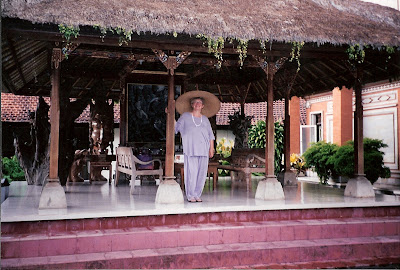balancing gebogan
on top of their heads, parading
to the odalan
The third odalan today is the largest, held at a village pura desa to celebrate the anniversary of the temple. Graceful young women keep filing in, bearing gebogan or banten tegeh, tall offerings. This is not an easy feat, as the offerings are not only tall but heavy, and the women use only one hand to keep the edifice balanced on top of their heads. Ida Ayu directs them where to place the one-meter-high offerings on the central bale, where incense sticks are placed in the gebogan. I am amazed at the amount, size, shape, color and variety of items in the offerings. It's like watching a homecoming parade, each "float" a work of art. Robin tells me that these gebogan can take weeks to make. Each one can cost 500,000 Rp, depending on the ingredients, which much be the finest.
The tukang banten, usually elderly women belonging to the Brahman caste, collect the ingredients, put them together and ritually purify them. They start with a soft banana trunk placed on a wooden dulang or metal bokor. The ingredients, pinned to the trunk with bamboo skewers, vary widely, but may include fruit such as banana, apple, pear, mandarin or salak, rice crackers, sweet cakes, flowers, grated coconut, roasted peanuts, rice pyramids or cooked chicken. Sampian, plaited coconut leaves, decorate the top. One woman at this odalan has brought a gebogan made of a pile of batik cloth, folded and stacked high.
A procession of priests dressed in white sangkul putih comes around, carrying sheaves and trays and sprinkling tirtha from narrow glass bottles with tapered metal spouts. To me, these holy water dispensers look like the bottles for oil and vinegar at restaurants back home. The pemangku bless the participants and the gebogan with the tirtha. After the gods have enjoyed the essence of the gebogan, the family will enjoy the offerings at home.
The whole celebration is extremely beautiful and colorful, with everyone dressed in their finest, all the buildings elaborately decorated and piled with mounds of gebogan. The purpose of all this beauty and delicious food is to please the many different gods who have been invited to come from the holy mountain to the temple. Pak Win tells me that the word banten may come from the Sanskrit word bali, which means tribute, obligation or gift. Or it may be derived from enten, which means to wake up or be conscious. An offering is a conscious awareness of the gods. He says offerings also have the purpose of binding communities together. The constant stream of celebrations certainly brings people together to feel the joy of giving gifts to the gods and to enjoy each other's company, surrounded by beauty, music and entertainment.


















































